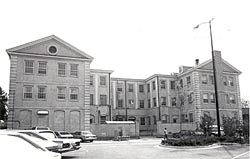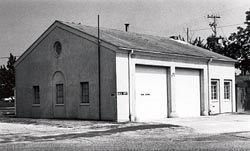
Pope Air Force Base (AFB) in Fayetteville, North Carolina, has played a leading role in the development of U.S. air power. Established within 15 years after the first successful powered flight in 1903, Pope Field is one of the oldest installations in the Air Force. Pope Field was officially established on April 1, 1919, by the War Department and named after Lt. Harley Halbert Pope, who was killed in an airplane accident on January 7, 1919. The 267th Aero Squadron was the first unit stationed at Pope Field, and many of its members were veterans of World War I. Their primary mission was to support the Artillery Regiment at Camp Bragg. Initially, balloons and hand-made, single-engine biplanes were stationed at Pope Field. Until 1927 the aircraft at Pope Field were used in passive roles, such as aerial photography, mapping of local terrain, spotting for artillery, reporting forest fires and carrying the mail. In 1927, Maj. Carl Spaatz led a flight of 14 Keystone B-1 Bombers from Pope to demonstrate the practicality of destroying bridges with aerial bombs. The destruction of a condemned bridge on the Pee Dee River confirmed his theory, and its application during World War II significantly shortened the war.
Pope Field was enlarged during the 1930s, and the 32 buildings comprising the Pope AFB Historic District were built during that period of expansion in 1933 and 1934. The district includes two distinct property types: administrative buildings and residences. Common architectural features of these buildings include hollow tile masonry walls, painted stucco exteriors, reinforced concrete foundations and, originally, Spanish tile roofing. One of the most noted buildings, Fleming Hall, which served as Command Headquarters during World War II, is a Georgian Revival, three-story building. The Old Fire Station, building 300, is a one-story building with Spanish tile roof and painted stucco facade--this site later became a Medical Supply building. The Old Family Housing units at Pope AFB consist of 21 one-and two-story dwellings on Etheridge, Maynard and Virgin streets--all characterized by hollow tile masonry set on concrete foundations, with wood floors, painted stucco exteriors, tile roofs, small rear stoops/porches and basements.
Throughout World War II, air and ground crews trained at Pope Field with Army airborne units in preparation for airborne and aerial resupply missions. In 1941 Generals Marshall, McNair and Clark visited Pope Field and witnessed one of the largest air maneuvers in history up to that time: the first mass paratroop drop (more than 500 paratroopers) undertaken in the western hemisphere. In February 1942, a squadron of A-20s based at Pope Field located and sank the first German submarine off the shores of the United States near Cape Hatteras and Cape Lookout. The 317th tactical Airlift Wing at Pope Field, which saw extensive service in the Pacific during World War II, was one of the first carrier-based fighter groups formed. After World War II, the Continental Air Command took over Pope Field and maintained control until 1950, when the Tactical Air Command assumed control. In October 1954, the 464th Troop Carrier Wing was transferred to Pope Field and a major period of facility expansion ensued. In 1958 the Wing converted from C-119s to C-129 aircraft, enabling it to establish tactical airlift capability.

During the 1960 earthquake disaster in Chile, Pope AFB was one of two primary areas used to provide medical supplies and personnel assistance to this country. Airlifts of men and materials were sent from Pope AFB to Florida in 1962 during the Cuban Missile Crisis, and the Wing received the Air Force Outstanding Unit Award in 1961 and 1963 for assistance to the Vietnamese Air Force. An increase in the Wing's operational capacity occurred with the arrival of the first Lockheed C-130 Hercules aircraft in 1963, enabling the Wing to carry U. S. Strike Command paratroopers and equipment to any war zone in the world. In 1971, the 464th TAW was deactivated and the 317th TAW administratively moved to Pope AFB. Today Pope Air Force Base is home to the 43rd Airlift Wing and two tenant units: the 23rd Fighter Group and the 18th Air Support Operations Group.
Visit the National Park Service Travel American Aviation to learn more about Aviation related Historic Sites.
Last updated: August 29, 2017
